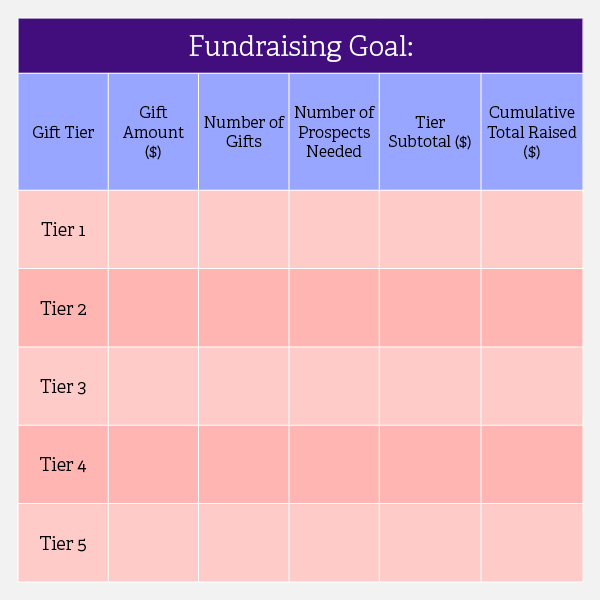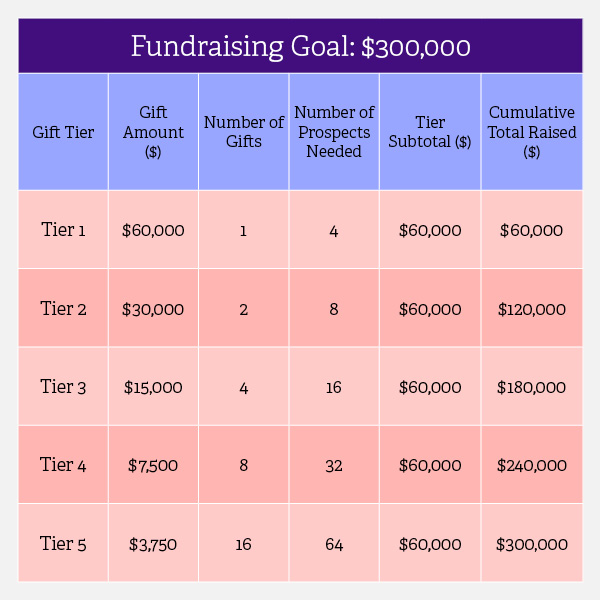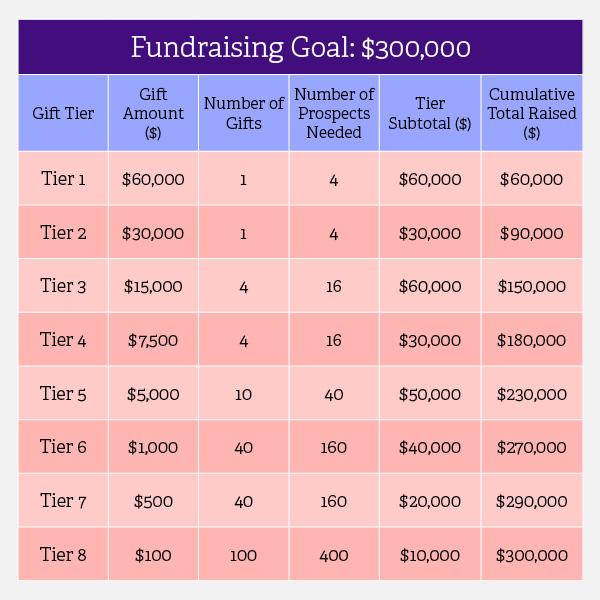Gift range calculators are designed to help nonprofit organizations determine their overall strategy for a giving campaign. This tool tells you the number of prospects and how much you’ll need each of them to give to reach your fundraising goal.
In this guide, you’ll learn not only how to build a gift range calculator for your nonprofit’s next fundraiser, but also how to create a plan for incorporating it into your campaign. You can also get started quickly by using our free gift range chart template below:

What is a gift range chart?
A few terms are often used interchangeably when discussing gift range calculators, but there are two concepts you should be able to distinguish between before you get started. A gift range calculator is the tool you use to predict donation levels and amounts. By contrast, a gift range chart or donor pyramid presents the results of a nonprofit’s gift range calculations in an easy-to-follow structure.
Gift range charts and calculators are particularly popular for capital campaigns because they segment major and mid-level giving opportunities into different levels. You can then use this information to guide your cultivation and solicitation strategy. As the gift amount increases, you’ll generally need to secure fewer gifts, so the number of prospects you’ll need will also decrease.
While most gift charts and gift range calculators are used to analyze major and mid-level donation amounts, they can help with planning any fundraising initiative. For example, you might also use the gift range calculator to factor corporate sponsorships, event ticket sales, or grant funding into your organization’s revenue totals.
How to make a gift range calculator in 6 steps
While there are many basic gift range chart generators online, creating a custom calculator takes your nonprofit’s unique situation into account and allows for more accurate fundraising predictions. Let’s walk through the process of developing a calculator by using sample figures that you can replace with your organization’s own numbers in the gift range chart template above.
1. Set your overall fundraising goal
In this scenario, let’s say your organization has an upcoming gala for which you hope to raise $300,000. This fundraising goal will be the starting amount for the calculations in the following sections, so it’s essential to establish your goal before developing your gift range calculator.
When determining your goal, remember to factor in the cost of staff work hours, donor recognition, and marketing for your campaign.
2. Estimate the largest gift you anticipate securing
The largest anticipated gifts in your chart will determine all of your other gift amounts. Most chart generators will predict the largest gift to be between 15% and 30% of your fundraising goal, although there is a high potential for variability.
It’s very possible that your wealthiest donor could end up contributing only 10%, or that a passionate major donor might be willing to contribute closer to 40% of your total. In either case, spend time up front making sure your predictions will be as accurate as you can make them.
For the gala example, let’s estimate the largest gift as 20% of the total fundraising goal, and 20% of $300,000 would be $60,000.
3. Figure out the remaining gift amounts
Now, you’ll calculate the gift amounts for your remaining tiers. In the provided template, there are five giving tiers, but you might choose to add more if your organization has many reliable smaller donors.
As you move down the tiers, divide each gift amount in half. If the highest gift amount is $60,000, the amounts for the following tiers would be:
- $30,000
- $15,000
- $7,500
- $3,750
You might notice that the lowest tier of $3,750 is still a high number for an event with a fundraising goal of $300,000. If your calculations at this stage seem unrealistic for your situation, don’t worry—you can always adjust the numbers as you work through the following steps.
4. Decide how many donors you’ll need at each level
For most gift charts, as you halve the gift amount at each tier, you’ll double the corresponding number of gifts. Using this formula, the number of gifts you’ll need at each tier in the gala example would be:
- Two gifts of $30,000
- Four gifts of $15,000
- Eight gifts of $7,500
- Sixteen gifts of $3,750
At this point, the gifts in each tier add up to the same amount—$60,000. In reality, your exact number of gifts will fluctuate depending on the size and giving capacity of your donor base, which you’ll account for later.
5. Determine how many prospects you’ll need for each tier
For every actual gift you’re anticipating in your gift range calculator, it’s best to have three to five prospective donors. At each giving tier, your prospective donors should be individuals whose giving history, past engagement, and demographic data indicate that they’re willing and able to make a contribution of that size.
Let’s estimate you’ll need four prospects for every gift earned in the gala example. You would need four potential donors for the highest giving amount, eight for the second tier, and 64 for the fifth tier.
Review your nonprofit’s past fundraising data to determine the percentage of prospects likely to convert to actual gifts at each giving tier. Your organization’s constituent relationship management (CRM) system and specialized prospect research tools can also be useful tools as you figure out this calculation.
6. Adjust your gift range chart
Once you reach this step, you’ll have a completed draft of your gift range chart. For the gala example, the draft will look like this:

To incorporate this chart into your actual fundraising plan, though, you’ll need to adjust your calculations. You may find that you have enough prospects for every tier except the two $30,000 gifts, for instance, and you might decide to sell more event tickets at a lower starting cost of $100. In this case, you could remove one gift from the second tier and include additional tiers to accommodate a variety of smaller donations, which would result in this sample chart:

How to apply your gift range chart
Once you’ve finalized your gift range chart, it can direct your organization’s donor stewardship and fundraising strategies. Leverage insights from your gift range calculator to inform how you solicit donations and cultivate relationships with your donors.
For instance, a gift range chart can:
- Help your nonprofit’s leaders and board members set smarter and more realistic goals.
- Provide a clearer understanding of current and prospective donors.
- Contextualize your fundraising asks.
- Compare your planned and actual donation totals to determine your organization’s fundraising success.
While your gift range chart can help you plan for each of your nonprofit’s fundraising campaigns, be prepared to pivot if necessary and continue to adjust your calculator for the best results over time.
The power of an accurate gift range chart
A gift range chart is most meaningful and predictive if it is built from up-to-date, accurate numbers. If your nonprofit’s gift range calculator is realistic and serves your organization’s unique needs, you’ll be in a strong position to raise more funds and further your purpose.




